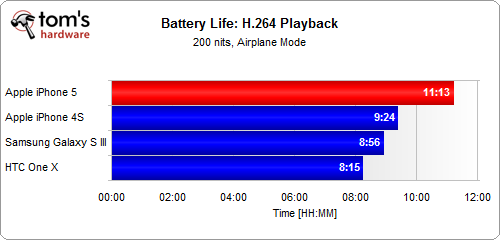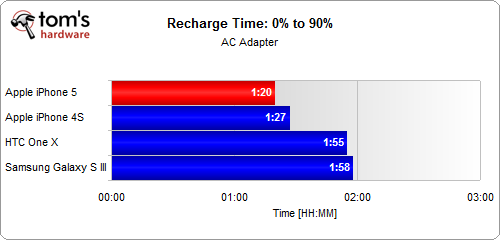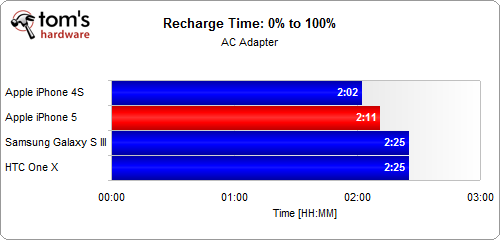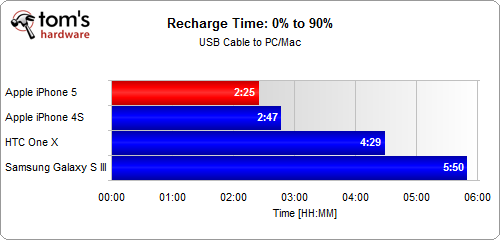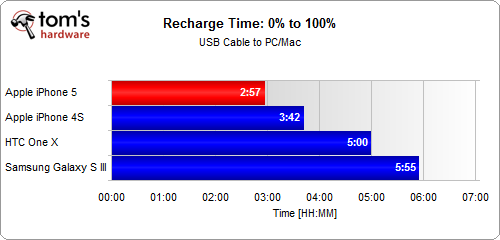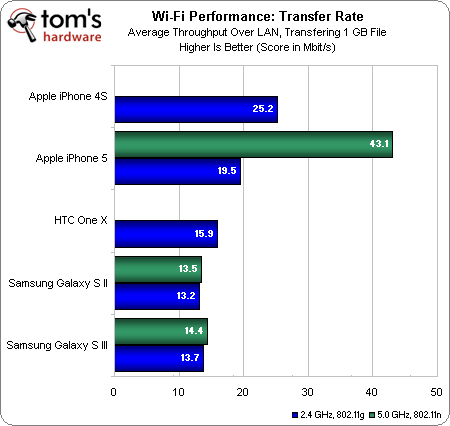Apple iPhone 5 Review: CPU, GPU, Battery, Wi-Fi, And Display Testing
Battery Life And Wi-Fi Performance
Battery Performance
The iPhone 5 is the first smartphone from Apple with a 16:9 aspect ratio, which works well with media files optimized for those same native dimensions. If you enjoy passing the time watching video, you'll be happy to know that the iPhone is a class-leader, boasting more than 11 hours of playback time with its screen set to 200 nits and Airplane Mode enabled.
Our talk time test is pretty simple. Using a land line, we call each smartphone and stream music over a microphone. This provides a constant stream of input that gets played back, helping keep the connection alive. The screen is naturally allowed to time out, which means LCD power consumption really isn’t a variable in this metric.
If you need a work day's worth of talk time, the iPhone 5 does suffice. However, the HTC One X and Samsung Galaxy S III are clearly better, outpacing Apple's latest and greatest.
As enthusiasts, we increasingly expect to have Internet access on all of our devices, no matter where we are (particularly in light of the speed enabled by 4G LTE). Our hotspot test, which consists of streaming YouTube video, tells us how long we can expect to use these phones as connectivity enablers for other pieces of technology.
Again, each phone's display is allowed to sleep automatically, which helps extend battery life. And surprisingly, Apple's iPhone 5 rises to the top in this metric. That's good news for mobile warriors looking to stay connected on, say, a notebook out of range of a readily-accessible Wi-Fi network.
Did you know that charging from an AC adapter is quicker than charging from a PC or Mac's USB port? Check out the two charts above the the two below; you can shave off quite a bit of wait time by simply hooking your iPhone up to the wall.
Get Tom's Hardware's best news and in-depth reviews, straight to your inbox.
We also know from experience that most devices charge from 0% to 90% battery life fairly rapidly, but then slow down quite a bit as they approach 100%. The difference that last 10% makes is clear in both recharge scenarios.
Wi-Fi Performance
In the interest of generating the most real-world results possible, we've been toying with new ways to measure Wi-Fi performance. In the past, we used IxChariot. It’s a professional tool for measuring network performance and helping diagnose issues. However, it's highly synthetic, and we wanted to conduct a test that'd be more representative of a task you might actually perform.
As a result, the throughput numbers we’re generating now come from configuring a local network share and downloading a 1 GB file. It's a simple enough test that should help determine maximum real-world transfer speeds.
The 5 GHz band is really only beneficial to the iPhone 5. Apple's iPhone 4S only supports 2.4 GHz, and the Galaxy S II/III demonstrate similar performance, regardless of the band we use.
HTC's One X does support 5 GHz connectivity, but we encountered an issue whereby it allowed us to browse the Web over the 5 GHz band, but wouldn't let us download our 1 GB test file.
Current page: Battery Life And Wi-Fi Performance
Prev Page Camera Quality: Better In Low Light; Purple Flare "Normal" Next Page Something New, But No Longer Revolutionary-
g-unit1111 Why can't everyone - Apple included - agree on a standardized power adapter like mini USB?? It would make not only our lives easier but the manufacturers who make these accessories able to have one device and on cord that works with everything.Reply -
mayankleoboy1 The LCD tests puzzle me a little. Most other reviews said that the SGS3 has a poorer display and the iphone5 has a better display , with much better contrast ratio and sRGB compliance.Reply
Maybe i am reading it wrong ? -
reprotected There needs to be more explanation in the quality of the screens. We all know Galaxy SIII covers a larger colour gamut, but does it beat the iPhone 5 in terms of accuracy is one big thing we want to know based on your eyes, not numbers and graphs.Reply -
kensingtron Great article ^_^Reply
Second to last paragraph:
"For example, Samsung's Galaxy S III has been on the market for a while, and its LCD is a market leader"
LCD = AMOLED -
acku kensingtronGreat article ^_^Second to last paragraph:"For example, Samsung's Galaxy S III has been on the market for a while, and its LCD is a market leader"LCD = AMOLEDReply
My apologies. On page 6 we mentioned that S3 uses AMOLED. I'll make a correction. Thanks for the shout out. -
dragonsqrrl Excellent article as usual, very comprehensive. Hopefully this helps to dispel some of the performance myths about the iPhone that seem to circulate here on Tom's.Reply -
acku mayankleoboy1The LCD tests puzzle me a little. Most other reviews said that the SGS3 has a poorer display and the iphone5 has a better display , with much better contrast ratio and sRGB compliance.Maybe i am reading it wrong ?Reply
http://news.cnet.com/8301-13579_3-57524291-37/color-me-prettier-galaxy-s3-display-outdoes-iphone-5s/ Check that one out. :)
I'd still like to add an accuracy test at some point. I need to think about how to approach that problem. The way people normally talk about color accuracy (besides deltae and gamma) are sometimes too abstract with color terms that professionals use. I'd like to find a way to present the information in a more intuitive manner. -
ojas g-unit1111Why can't everyone - Apple included - agree on a standardized power adapter like mini USB?? It would make not only our lives easier but the manufacturers who make these accessories able to have one device and on cord that works with everything.Agreed...though don't most smartphones today use the microUSB B-type connector?Reply -
dare2blink Seems apple has not inovated for a couple of years now. I´m shocked that the most inovative and arguably the best phone of the year is not even mentioned in this article. Nokia Lumia 920 is definitely the most inovative na the most complete phone reseased so far. It has much better build quality, a better screen and camera than the iphone 5, not to mention a much more inovative OS.Reply
